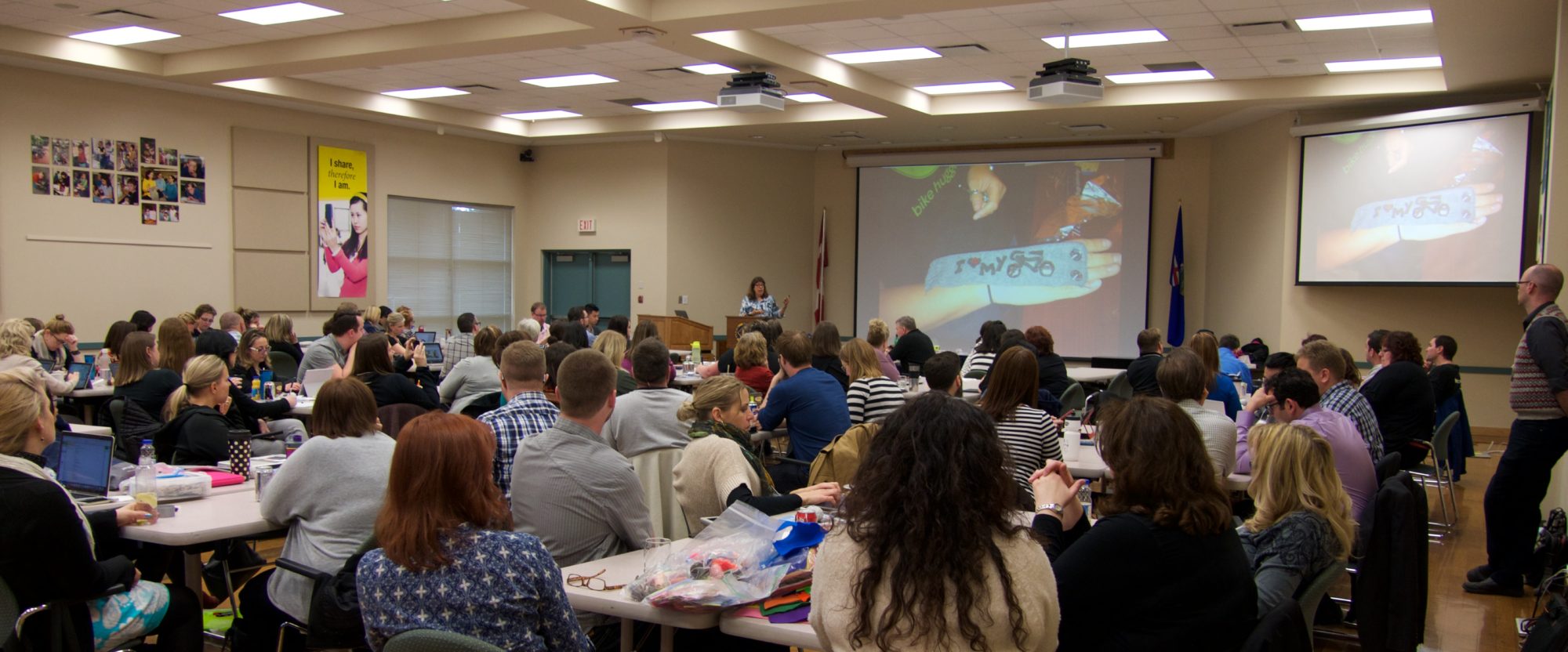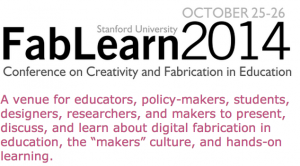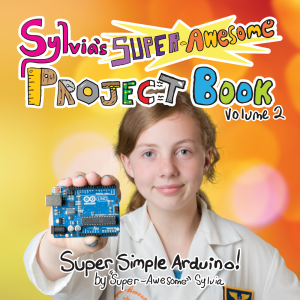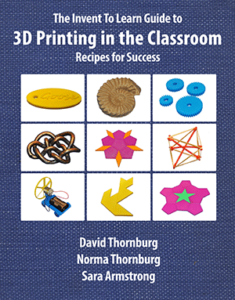I recently gave the closing keynote at the Maker Possibilities Day hosted by the Maker Education Organization and sponsored by Intel. It was interesting, because I knew that most of the attendees were already implementing making in various classrooms and informal educational settings. So I couldn’t do my regular keynote where I introduce the Maker Movement to educators and show examples of how technologies like 3D printing, robotics, wearable computing, programming, and more can be used to transform learning. This audience was well beyond that!
So I created a new talk – “The Top Ten Things Maker Educators Know” as a David Letterman style top ten list.
#10 – Just do it.
You know you can’t wait for the perfect space, budget, bandwidth, software, version. Waiting won’t make it better. Try things and then try again. Let your students help you and learn alongside them. We ask our students to take risks, make mistakes, and reach for the stars – we have to do the same.
#9 – Making things is good – computers make good things better.
We know we have to hold ourselves to higher standards and constantly push to make the “making” experiences intellectually challenging. We have to be brave enough to push ourselves to use these tools that didn’t exist when we went to school. In our book we identify three game changers – fabrication, physical computing (including robotics, wearables, e-textiles, and more), and programming.
The game changer is the computer and the computation. Alan Kay said, “the computer is an instrument whose music is ideas.”
The act of making is not good enough to claim it is always educational. I love arts and crafts, but we can’t claim that any making belongs in schools unless we can really prove that the experiences are rich and academically relevant. I didn’t say “traditional” – but…
We can be rigorous. We can add measurement, precision, context, connections to curriculum, history, and anything else you can think of. My co-author, Gary Stager reminds us that “And then…” is a good stance to take when you think about student projects. If you are making instruments… “and then?”… can you make music? And then, can you write it down so others can play your songs? If you make a car, can you make it go fast, and then… can you make a sensor that measures that speed? And then… Can you prove that your measurements are correct? We can’t be satisfied saying, “oh, kids learn how to solve problems, or they learn to persevere (even if that’s true and wonderful) — it’s not enough. The computer is the key to pushing that envelope, as a design partner and engine of your ideas.
#8 – You can’t hurry love. Or learning.
Maker educators know it takes time. Time to learn. Time to do the job right. Time to take a break and ponder. Time to make mistakes and try try again. We want kids to learn how to dive deep into interesting tasks and then we ring a bell every 42 minutes.
I know this is SO hard. We have schedules. The bell rings, the calendar turns, grades are due. How do you make sure “things get done” – well, maybe we have to relax a little about that. Find ways to give kids the time to step back like a painter who takes the time to look at their unfinished work and think about their next brushstroke. To reduce the stress and chaos of the classroom. To move towards longer, richer projects and away from “if it’s Tuesday it must be exponents” approach to subjects.
Those of you in informal, non-graded programs have more flexibility. But even so, it’s so easy to fall into the quiz-on-Friday trap just because we are used to learning equaling “school”.
I know this is a big ask. For most schools, the bell and bus schedule are written in stone and come down from the heavens…And yes, for some of you, the ones who will be hardest to convince will be the kids — they know the game of school – when is it due? How many pages?
Which brings me to #7….
#7 – Educate everyone.
Of course I mean the students, if you are changing to longer projects tell them. Tell them why. They will whine and howl and the parents will come in and question your qualifications – or sanity … but – you need to be able to articulate why learning isn’t about timed multiplication tests or spelling bees. That’s what days like this are for – to help you concretize what you believe about learning. That you aren’t the only teacher trying to do this. To listen to someone else’s elevator pitch for their makerspace dream. Look around at your new support system.
Stay in touch – hashtag MAKERED
Days like this are to remind you that we DO know a lot about how people learn. (not that you can tell from a lot of what we do in schools)
We KNOW that knowledge is a consequence of experience. That working with your head, heart, and hands cements that knowledge better than memorizing. That being engaged in meaningful work is the ONLY way that people learn.
We wrote several chapters in our book about “making the case” for making in the classroom – with research, stories, resources. Some of you have told me today that our book helped you. I’m thankful and immensely gratified when I hear this.
But you are the way it’s going to happen. You have to constantly reach out to parents, your students, your colleagues, your administrators and leadership teams, your funders, your neighbors, the guy on the bus talking about “these kids today…”. You can educate everyone about what you see and how this changes kids lives. You can share your stories. How rich learning opportunities are important for ALL kids, and that they need them EVERY day, not “after the tests” or “after they master the basics”.
If public education means anything, it’s a way to democratize access to expertise and experience. Poor kids needs MORE experiences, MORE connections to the real world, MORE opportunities to touch the future with amazing tools like 3D printers. Instead we are told that “those kids” need to master basics and learn how to behave before they get “enrichment”. And whose kids are “those kids” – yeah, we know which ones they are. Not the kids of the politicians making these speeches. They need to be educated too.
And yes, this is a tough job.. educating the whole world, maybe impossible. But we have to do it anyway.
#6 – STEM for all.
But while we educate, we have to be careful about jumping on the bandwagon of STEM jobs. Sure there are kids who will be scientists, mathematicians, programmers, or engineers, but that’s not the reason to teach STEM in an engaging and exciting way. It’s good – but it’s not good enough to just pluck out another few kids who might get that plum STEM job.
No, I believe that we owe it to ALL kids to construct experiences that help them see science as a detective story, engineering as a way to solve their own problems or the world’s problems, and math as a way to make sense of the world. With the tools and technology we have today we don’t have to just teach “about” these things, students can BE mathematicians, BE historians, BE engineers and BE software developers. This can happen now if we tackle making STEM subjects interesting and accessible – not just to fill some economic balance sheet, or crush other countries – but as a human right. That our democracy and the future of the world depends on an informed, educated community –every adult, every child.
So yeah, I get it. It’s a buzzword and there is funding for STEM. Get the money! But let’s make sure that what we create is fundamentally aimed at reaching every child – not just the usual suspects, not just a lucky few. That might be difficult – to change people’s minds that only SOME kids need to know science, only SOME kids need to learn programming. Maybe even impossible – I know, but we have to do it anyway.
#5 – Balance. all kinds – Gender, problem solving styles, artistic interest, ages.
I’m a girl, I’m an engineer – do I care about girls in STEM? Of course I do. I worry that courses and careers are more difficult for females for a wide variety of reasons. We know them – the culture, tradition, economics…Just yesterday I saw ANOTHER study about how teachers respond to boys questions with longer answers than girls. I worry that research about the effects of stereotype threat aren’t taken seriously. That maker spaces often look like places where girls WONT be welcome. And yes, the Maker Movement has more than its share of bro-grammer testosterone.
But then again, when I look around Maker Faires I see lots to cheer for. I see heroes of Maker Movement of all ages, from veteran wood workers to Super-awesome Sylvia, a 12 year old girl – being celebrated and respected. I see so much art and whimsy incorporated into techie projects. I see respect for different points of view, for different ways to see the world, different ways to solve problems.
But in school, we only respect one way – the analytical, linear problem solving approach. Seymour Papert, father of educational technology said there are two ways to solve problems: Analytical and bricolage. Bricolage is a French word meaning tinkering. But it also has a connection to the Maker Movement – in French, it has a connotation of reuse and artistry in your tinkering.
Analytical styles have long been seen as more “academic” – the linear, step-by-step approach is taught and reinforced in school, especially in higher grades. We push abstractions on students at younger and younger ages and call it rigor. And yet, there is another way. Bricolage, or tinkering is often how real science happens. I know as an engineer there were many more times we tinkered our way to success rather than planned it.
Real scientists make mistakes, ponder, have a cup of tea, argue with each other, and sometimes have happy accidents. Bricolage is the way designers work as well, the real process of design, and I believe a natural progression from the play of childhood to a more reasoned and directed approach, but still a non-linear and iterative way to solve problems.
Sherry Turkle showed in her groundbreaking work that these two styles are associated with gender. That bricolage – an intuitive, creative problem-solving style, what she called “soft mastery” is often discounted as being immature or naïve. You can see that these adjectives appear to describe a more “feminine” style.
Of course I’m not saying that all boys solve problems one way, and all girls the other – most people use a combination of styles.
We used to literally tie left-handed kids hands behind their backs and force them to write with their right hands. We know now, that that causes serious learning problems, stuttering, life-long consequences.
I think we are still figuratively tying students hands behind their backs by insisting they all solve problems in preferred “analytical” ways, ignoring not only the fact that we are hurting them, but also that analytical isn’t even the way real designers and engineers work.
When we discount people’s problem solving styles we communicate to them that they aren’t “smart” – and millions of people are being convinced every day that they aren’t smart. That their ideas aren’t welcome. It’s not true, and it’s a shame and a waste.
We have to find ways to honor all problem-solving styles, to allow people to master knowledge in their own way. This is harder than everyone doing problem 12 on page 47 on the same day at the same time. Teaching in a way that supports multiple learning paths and styles is harder to do, maybe impossible to scale – and yet we have to do it anyway.
# 4 – This doesn’t just happen.
People say things about technology like, Oh the kids are so smart they will figure this stuff out by themselves. Old fuddy duddies should just step aside… Or – we’ll just let the kids mess around and discover things.
Personally, I never use the term “discovery learning” it’s too easy to mock. “oh the kids will wander barefoot through the field with flowers in their uncombed hair and lo and behold — the Pythagorean Theorem! oh please. That’s not going to happen. It’s up to caring, trained people who are experts in their subjects AND in the art of teaching who can create situations where running into big ideas, powerful ideas is inevitable. Deliberately prepared, yet open learning experiences that are rich and valuable. This doesn’t just happen. It takes skill, passion, and sometimes years of experience working with children.
It’s an art to listen for that teachable moment and then know what to do next, ask the question that unlocks a door that THEY can walk through, offer the right book or the right tool, or just leave them alone sometimes. It’s an art to gather the right materials, ones that have a low threshold and a high ceiling, and challenge kids to push past their comfort zones. Teachers and leaders are the key to making education better and the key to incorporating the power of the Maker Movement, of infusing the power of technology into our schools and learning spaces.
#3 – Engaged and empowered is an outcome of doing meaningful work.
People say technology is so engaging to kids. I think they get it wrong. Maker educators know there is more to it than bells and whistles.
Kids are engaged by doing important work – work that is challenging in a way they find interesting. Mastering something difficult and important in the eyes of the world, like technology is engaging. If you can then share your expertise, so much the better.
This is a cycle of citizenship – of belonging to a community that gives you value and values you. We often talk about “digital citizenship” when we really just mean telling the kids the rules and how they will be punished if they mess up. But a learning community is a two-way street.
When you give someone responsibility, and they step up, they build trust in themselves and trust in their ability to do the next difficult thing. They engage in learning. They become empowered because they did something powerful. You can’t teach empowerment or do empowerment TO kids. It’s an outcome of doing meaningful work – meaningful to yourself and to others.
And by the way, you can’t have empowered students without empowered teachers. Script reading robot teachers will not empower students. We have to fight against the devaluation of teachers, and the devaluation of kids as cogs in some corporate education machine. We can do this, we can change minds, even if it’s hard -even if it seems impossible. We just have to do it anyway.
#2 – Making is about making sense of the world not making stuff.
Maker educators know that making isn’t about a shopping list or a special room, it’s about allowing people to reach their full potential as makers of meaning. Humans naturally seek meaning in their lives. Every kid wants to change the world – we can give them the tools and the maker “get it done” ethos that makes it possible.
We know the world is full of big problems that need solving. Our kids need to believe they can change the world. Not in magical superhero ways, but ways that are real. We need them to believe they can solve problems – and even when it seems impossible – we need them to do it anyway.
#1 – You (and your kids) are the right people.
You knew this was coming. But…. maybe you doubt that you are the right person to show others the way forward. That someone else should speak up, someone else should lead the way.
There is a problem-solving technique called “open-space technology” that has a motto that I love. It’s “the people in the room are the right people.” I think it applies to everything. Every classroom, every learning space has the right kids to tackle making things, important things, things that no one has ever thought of before. Even when those kids are disempowered and disengaged. Even when no one expects anything from them. They still are the right kids. Amazing kids, extraordinary kids. You’ve seen them, you know them.
And we have the power, the people in this room, to change education, to change the way we value children in this society. To respect and honor EVERY child’s potential to be a maker of meaning, and a maker of a better world.
And yes, we know it’s a tough job, and yes, it may seem impossible, but we are the right people … so we have to do it anyway.
 This book is an essential guide for educators interested in bringing the amazing world of 3D printing to their classrooms. Learn about the exciting technology, powerful new design software, and even advice for purchasing your first 3D printer.
This book is an essential guide for educators interested in bringing the amazing world of 3D printing to their classrooms. Learn about the exciting technology, powerful new design software, and even advice for purchasing your first 3D printer.


 This book is an essential guide for educators interested in bringing the amazing world of 3D printing to their classrooms. Learn about the exciting technology, powerful new design software, and even advice for purchasing your first 3D printer.
This book is an essential guide for educators interested in bringing the amazing world of 3D printing to their classrooms. Learn about the exciting technology, powerful new design software, and even advice for purchasing your first 3D printer.